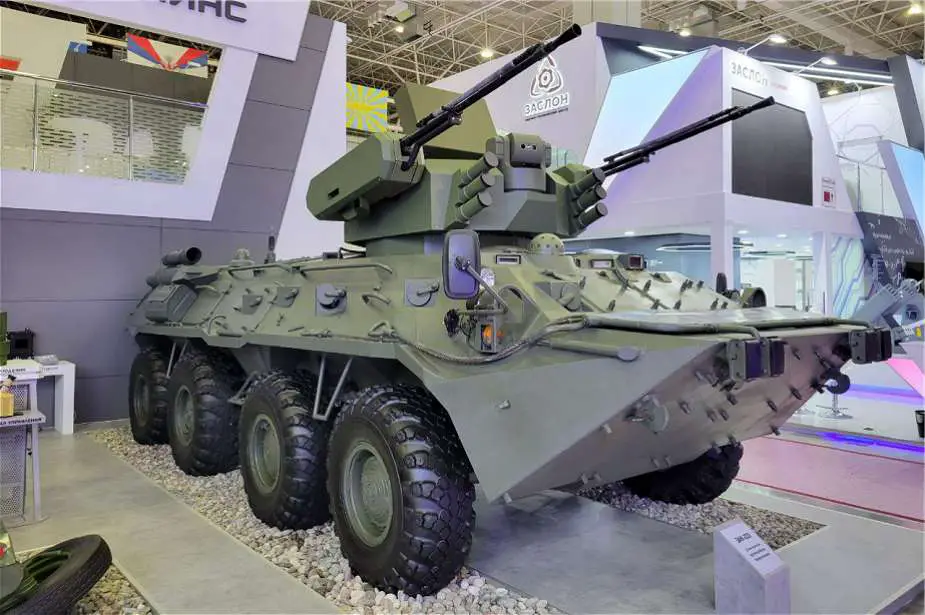Breaking news
Russia unveils new ZAK-23E 8x8 mobile air defense system at Army-2023.
At the Army-2023 event, Russia unveils its latest 8x8 self-propelled anti-aircraft gun (SPAAG) known as the ZAK-23E Short-Range Air Defense System (SHORAD). This system includes two ZU-23 23mm automatic cannons mounted on the BTR-82A armored personnel carrier. Collaboratively developed by JSC Tulamashzavod and JSC Elins Research and Development Center, it is being presented as a prototype, with the main purpose of protecting both static military units and moving convoys.
Follow Army Recognition on Google News at this link

Russia unveils new ZAK-23E 8x8 mobile air defense system at Army-2023 (Picture source Nothing to see/Twitter)
With a firing rate of up to 3500 rounds per minute, the ZAK-23E is capable of engaging targets within a distance of up to 2.5 km (approximately 1.5 miles) and at altitudes of up to 2,000 m. Equipped with advanced optoelectronic detectors, it has the ability to autonomously engage incoming aerial threats such as drones, helicopters, and cruise missiles.
The BTR-82A armored personnel carrier, serving as the platform for the ZAK-23E, is an evolution from the earlier BTR-80A model. Developed by Russia's Military Industrial Company (MIC), the BTR-82A emphasizes enhanced firepower, mobility, and protection. Its integrated fighting module accommodates cannons and machine guns within a stabilized turret, ensuring firing accuracy while the vehicle is in motion. Protective features like a reinforced floor, energy-absorbing seats, and advanced ballistic materials prioritize crew safety.
The ZAK-23E derives its effectiveness from the integration of 2A7M anti-aircraft guns, similar to the 2A10M quad-mount often used in various systems such as the ZSU-23-2 and ZSU-23-4. These 23mm autocannons, descended from the older ZU-23-2 model, are intended for countering low-flying aerial targets as well as armored vehicles.
The lineage of the ZU-23-2, dating back to the late 1950s, precedes the anti-aircraft guns integrated into the ZAK-23E. It employs armor-piercing-incendiary-tracer (API-T) and high-explosive incendiary-tracer (HEI-T) rounds to engage both aerial and ground targets. With a manual aiming mechanism assisted by the ZAP-23 optical-mechanical sight, the system is capable of targeting within an elevation range of +90° to -10° and a complete 360° traverse capability. The ZU-23-2 has seen extensive use across more than 20 global armies and continues to serve as a reliable anti-aircraft solution.
A self-propelled anti-aircraft gun (SPAAG) is a specialized military vehicle designed to provide mobile anti-aircraft defense using mounted anti-aircraft weaponry. An 8x8 self-propelled anti-aircraft gun, like the ZAK-23E, offers a combination of advantages and limitations that influence its combat effectiveness.
The ZAK-23E's foundation on the BTR-82A armored personnel carrier, incorporating protective features like a reinforced floor, energy-absorbing seats, and ballistic materials, underscores its commitment to crew safety during anti-aircraft engagements. The inherent mobility of the 8x8 platform ensures that the vehicle can respond promptly to emerging threats in various operational settings. This agility guarantees its presence in areas where airborne threats are a concern.
Thanks to advanced optoelectronic detectors, the ZAK-23E can independently detect and engage incoming threats. These integrated sensors equip the system to counter a range of aerial adversaries, including drones, helicopters, and cruise missiles.
The combination of ZU-23 23mm automatic cannons with the 8x8 mobility provides the ZAK-23E with an impressive firing rate. This capacity enables rapid and sustained engagement of multiple targets, enhancing its capability to address threats promptly. The 8x8 configuration equips the ZAK-23E with versatility in navigating diverse terrains. Its off-road capabilities allow the system to access various locations, expanding its operational scope.
Similar to other SPAAG systems, the ZAK-23E's engagement range is naturally limited compared to specialized long-range air defense systems. This limitation could impact its effectiveness against high-altitude or distant targets.
While utilizing the BTR-82A enhances protection, SPAAGs, including the ZAK-23E, remain susceptible to an array of threats, including ground-based attacks and artillery fire. This vulnerability necessitates strategic placement and support units to ensure comprehensive defense. The relatively compact space on the 8x8 platform might constrain ammunition capacity. This factor underscores the importance of efficient logistics to sustain extended engagements without interruption.
The integration of advanced optoelectronic detectors and targeting systems introduces operational complexities to the ZAK-23E. Proficient operation, diligent maintenance, and effective crew training are critical for optimizing system performance. The development, deployment, and maintenance of the ZAK-23E as an advanced SPAAG are also associated with costs. Evaluating these expenses against the system's advantages and operational requirements is an important aspect of decision-making.
In conclusion, the ZAK-23E, as an 8x8 SPAAG, offers benefits such as enhanced crew protection, rapid deployment, and integrated optoelectronic detection. However, it also faces limitations like restricted long-range engagement and vulnerability to diverse threats. Assessing these pros and cons within the context of operational necessities and strategic considerations is essential for informed deployment.


























